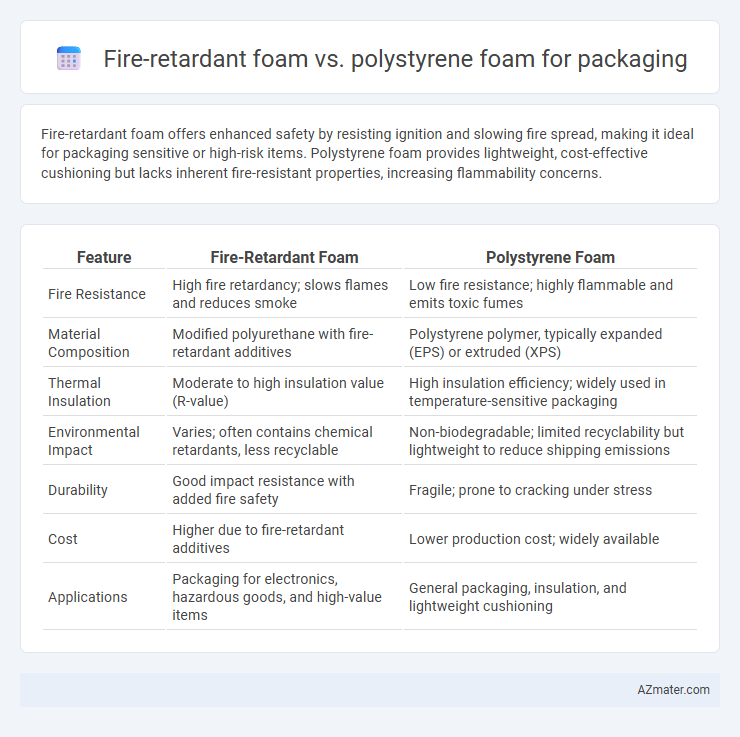Fire-retardant foam offers enhanced safety by resisting ignition and slowing fire spread, making it ideal for packaging sensitive or high-risk items. Polystyrene foam provides lightweight, cost-effective cushioning but lacks inherent fire-resistant properties, increasing flammability concerns.
Table of Comparison
| Feature | Fire-Retardant Foam | Polystyrene Foam |
|---|---|---|
| Fire Resistance | High fire retardancy; slows flames and reduces smoke | Low fire resistance; highly flammable and emits toxic fumes |
| Material Composition | Modified polyurethane with fire-retardant additives | Polystyrene polymer, typically expanded (EPS) or extruded (XPS) |
| Thermal Insulation | Moderate to high insulation value (R-value) | High insulation efficiency; widely used in temperature-sensitive packaging |
| Environmental Impact | Varies; often contains chemical retardants, less recyclable | Non-biodegradable; limited recyclability but lightweight to reduce shipping emissions |
| Durability | Good impact resistance with added fire safety | Fragile; prone to cracking under stress |
| Cost | Higher due to fire-retardant additives | Lower production cost; widely available |
| Applications | Packaging for electronics, hazardous goods, and high-value items | General packaging, insulation, and lightweight cushioning |
Introduction to Packaging Foams: Fire-Retardant vs Polystyrene
Fire-retardant foam in packaging offers enhanced safety by reducing flammability and preventing the spread of fire, making it ideal for sensitive or high-risk applications. Polystyrene foam, known for its lightweight and excellent cushioning properties, is widely used in packaging but lacks inherent fire resistance. Selecting between fire-retardant foam and polystyrene foam depends on balancing safety requirements with cost-effectiveness and protective performance.
Chemical Composition and Structure Comparison
Fire-retardant foam typically incorporates chemical additives such as brominated or phosphorus-based compounds that enhance its resistance to ignition and slow down flame propagation, whereas polystyrene foam is primarily composed of styrene monomers polymerized into a rigid, closed-cell structure with limited inherent fire resistance. The molecular architecture of fire-retardant foam often includes cross-linked polymers that integrate flame-retardant elements within the polymer matrix, resulting in improved thermal stability and reduced flammability. In contrast, polystyrene foam's simpler linear or lightly branched polymer chains lack these specialized additives, making it more susceptible to melting and combustion under high temperatures.
Fire Safety Performance: Key Differences
Fire-retardant foam contains chemical additives that significantly reduce flammability and slow the spread of flames, offering enhanced fire safety performance compared to standard polystyrene foam. Polystyrene foam, although lightweight and cost-effective, is highly combustible and releases toxic gases when exposed to fire, posing greater risks in packaging applications. The superior fire safety characteristics of fire-retardant foam make it ideal for packaging sensitive or flammable goods that require compliance with stringent fire safety regulations.
Environmental Impact and Sustainability
Fire-retardant foam typically contains chemical additives that can release harmful toxins during production and disposal, posing environmental risks and challenges for recycling. Polystyrene foam, while lightweight and effective for packaging, is non-biodegradable and contributes significantly to plastic pollution due to its persistence in ecosystems and low recyclability. Sustainable packaging solutions increasingly favor alternatives with lower environmental footprints, emphasizing biodegradable materials and foams free from toxic retardants to reduce long-term ecological harm.
Physical Strength and Durability
Fire-retardant foam offers enhanced resistance to heat and flames, making it ideal for applications requiring safety alongside moderate physical strength, though it may be less rigid than polystyrene. Polystyrene foam exhibits superior compressive strength and durability, providing excellent cushioning and shock absorption for heavy or delicate items during transport. When prioritizing physical strength and long-term durability, polystyrene foam generally outperforms fire-retardant variants, but fire-retardant foam ensures compliance with stringent safety standards.
Cost Analysis: Fire-Retardant vs Polystyrene Foam
Fire-retardant foam typically incurs 20-30% higher material costs compared to standard polystyrene foam due to specialized chemical additives enhancing flame resistance. Polystyrene foam remains more cost-effective for large-volume packaging applications, with lower production and raw material expenses contributing to its affordability. Evaluating total cost should consider not only initial outlay but also potential savings from reduced fire risk and compliance with safety regulations when using fire-retardant foam.
Regulatory Compliance and Industry Standards
Fire-retardant foam exhibits enhanced compliance with stringent fire safety regulations such as UL 94 and FM Global standards, making it more suitable for industries demanding high flame resistance in packaging materials. Polystyrene foam, while widely used due to its lightweight and cushioning properties, often falls short in meeting rigorous fire retardancy criteria and may require additional chemical treatments to comply with regulatory guidelines like the EU's REACH or the US Consumer Product Safety Commission standards. Selecting fire-retardant foam ensures alignment with industry-specific certifications and reduces liability risks associated with flammability in packaging applications.
Application Suitability in Packaging
Fire-retardant foam offers enhanced safety for packaging applications requiring compliance with stringent fire safety regulations, making it ideal for electronics, aerospace, and medical device shipping. Polystyrene foam provides excellent cushioning and shock absorption for general packaging needs, especially for lightweight, non-flammable goods like consumer electronics and food containers. The choice depends on the product's sensitivity to fire risk and regulatory standards, balancing protection with safety compliance.
User Experience and Customer Feedback
Fire-retardant foam offers enhanced safety and peace of mind by reducing flammability risks, which users frequently highlight in positive customer reviews, praising its reliability in high-risk environments. Polystyrene foam is often favored for its lightweight nature and cushioning effectiveness, though some customers express concerns about its flammability and environmental impact. Overall, feedback indicates fire-retardant foam provides superior protection and satisfaction for safety-conscious consumers, while polystyrene remains popular for cost-effective, general-purpose packaging needs.
Future Trends in Packaging Foam Technology
Fire-retardant foam and polystyrene foam represent distinct materials in packaging, with fire-retardant foams gaining traction due to increasing safety regulations and demand for sustainable alternatives. Innovations in bio-based fire-retardant formulations and enhanced recyclability are driving future trends, while polystyrene foam faces challenges from environmental concerns and regulatory restrictions. Emerging technologies emphasize lightweight, flame-resistant, and eco-friendly foam solutions to meet evolving consumer and industry needs in packaging.

Infographic: Fire-retardant foam vs Polystyrene foam for Packaging
 azmater.com
azmater.com